Global Crystallographic Texture of Pyrite in Fossil Wood (Jurassic, Oryol Region, Russia)
Abstract
Simple Summary
Abstract
1. Introduction

2. Materials and Methods
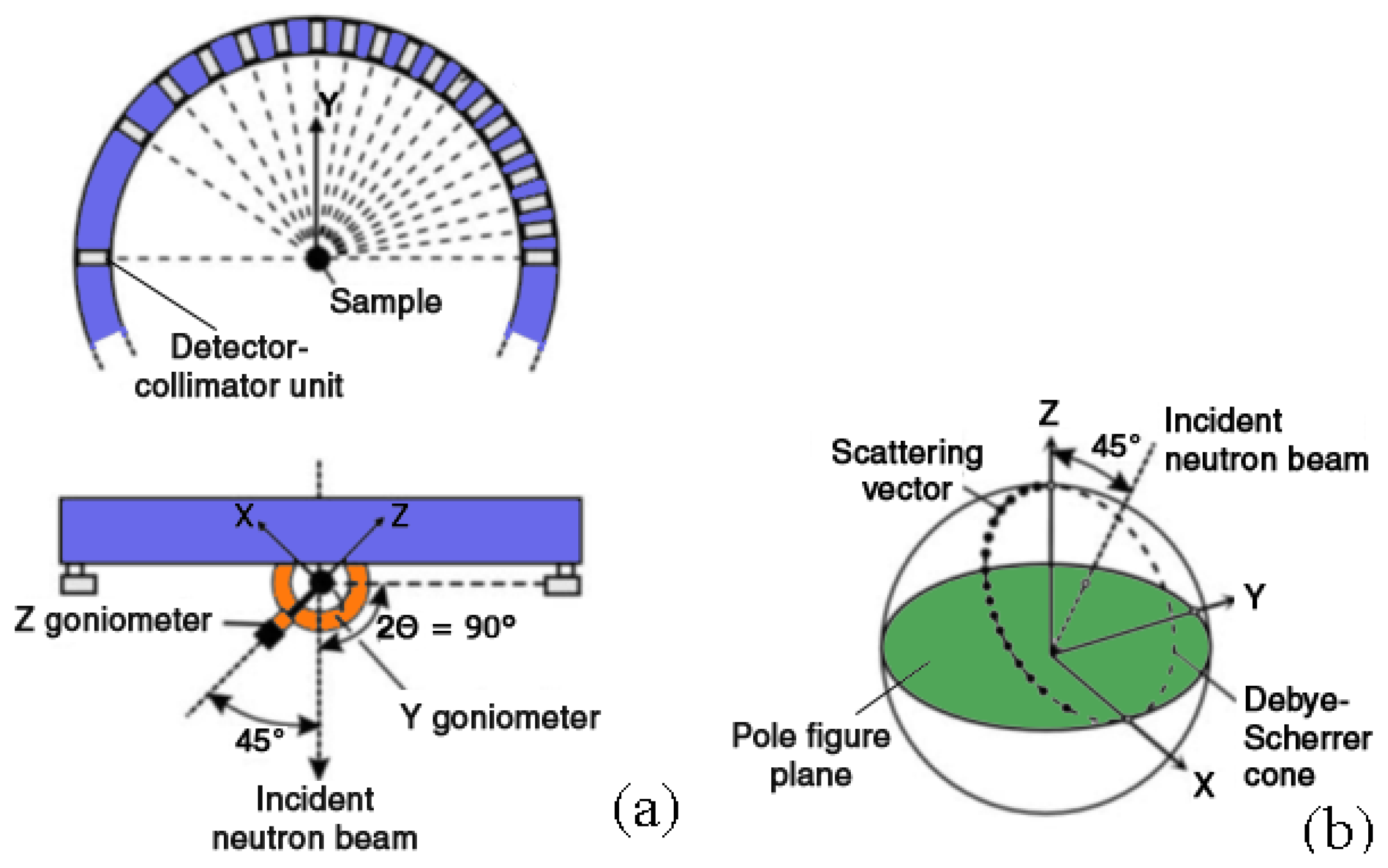
3. Results
3.1. Wood Preservation
3.2. Microstructure and Distribution of Chemical Elements in Wood
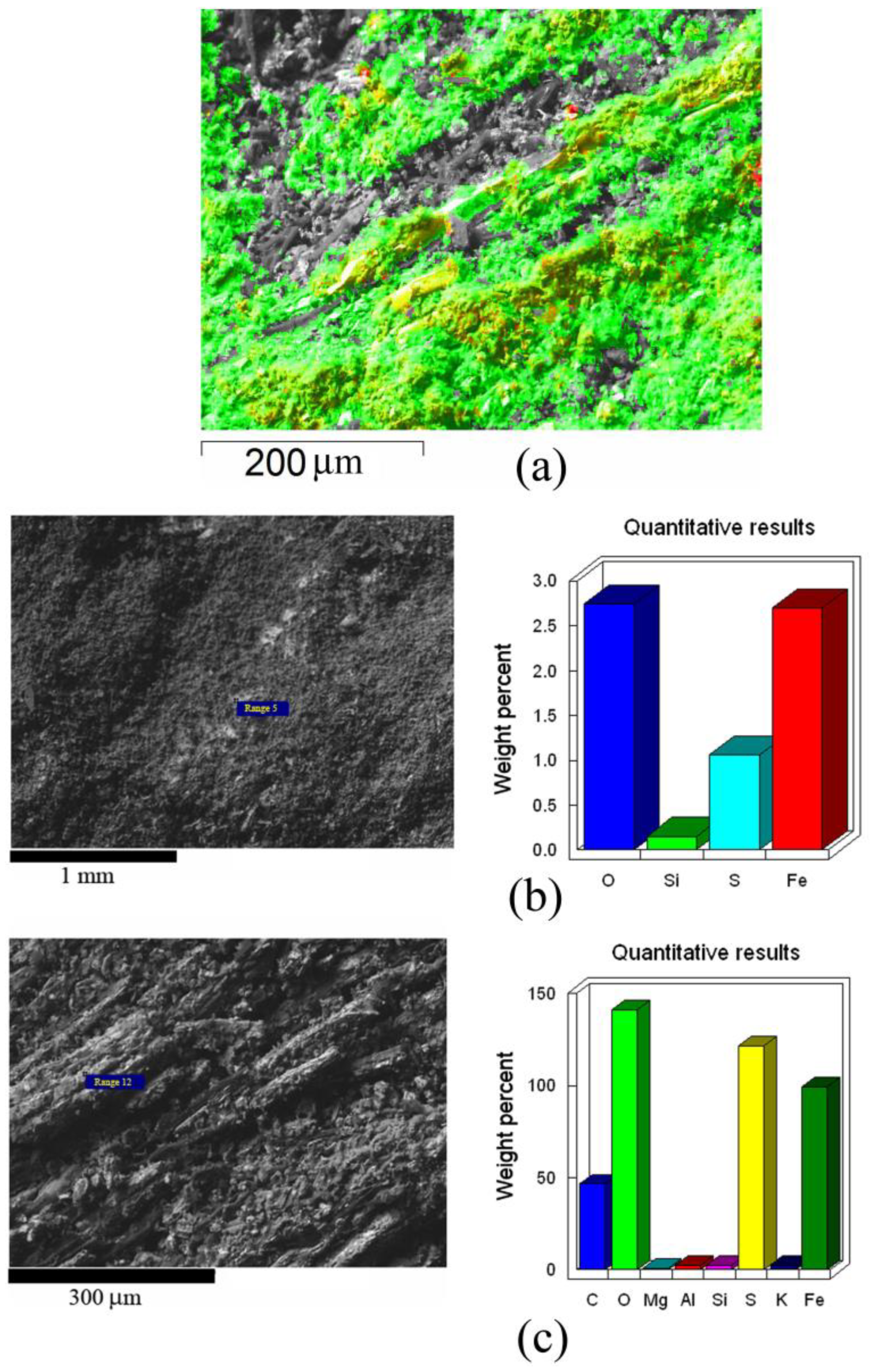
3.3. X-ray Microtomography of Pyritized Wood and Pyrite Nodules
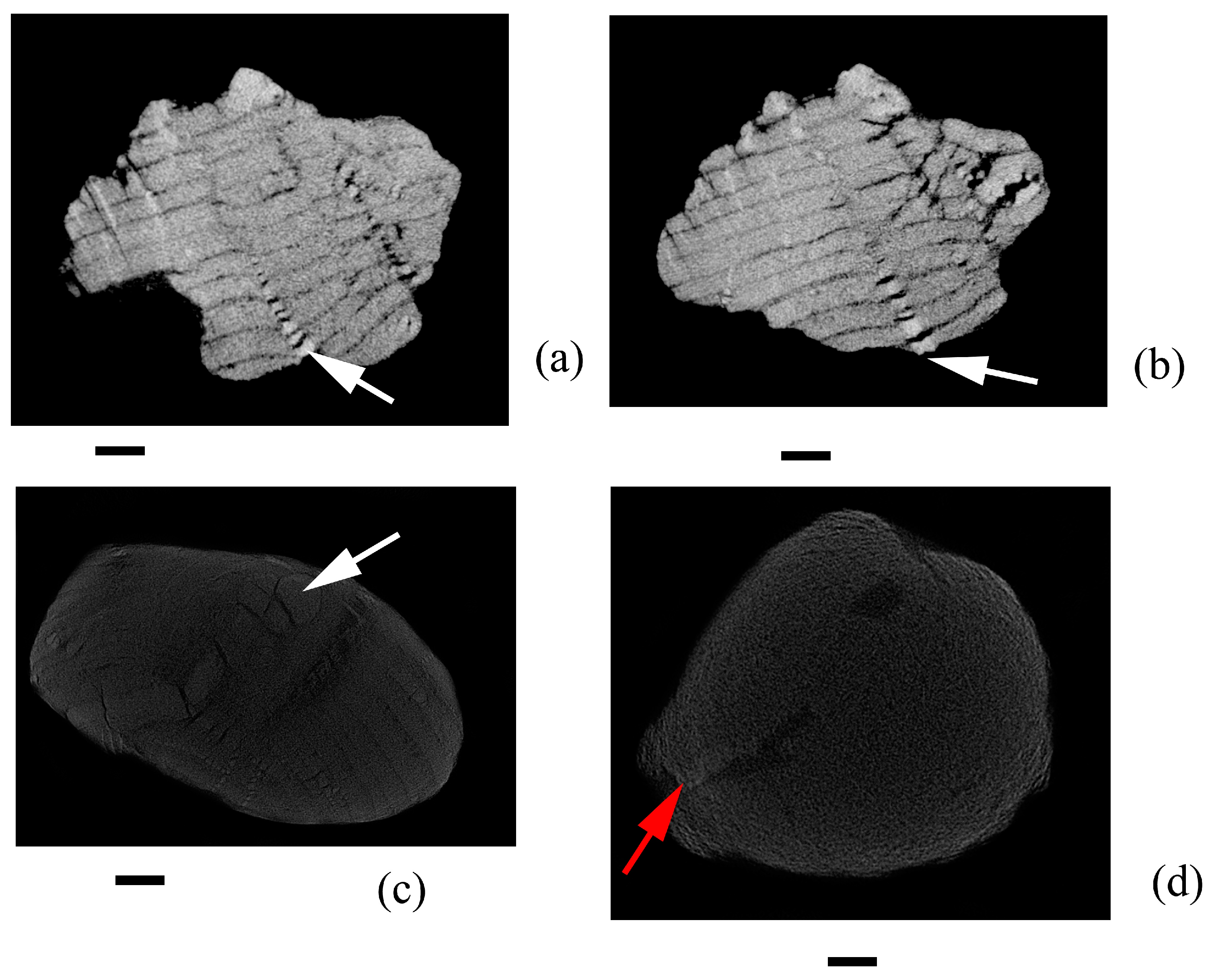
3.4. Global Crystallographic Texture of Pyrite
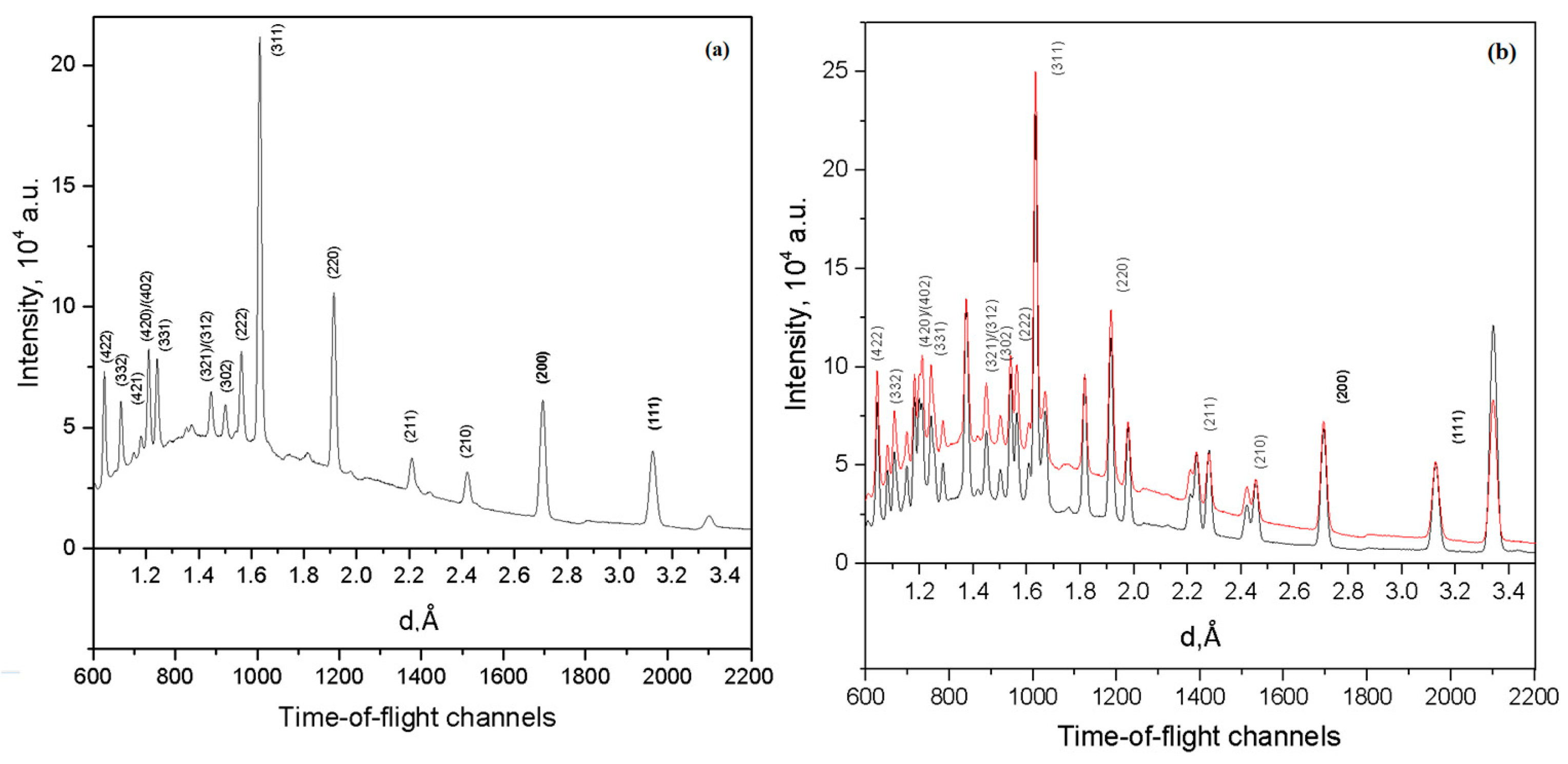
4. Discussion
5. Conclusions
Supplementary Materials
Author Contributions
Funding
Data Availability Statement
Acknowledgments
Conflicts of Interest
References
- Mustoe, G.E. Wood petrifaction: A new view of permineralization and replacement. Geosciences 2017, 7, 119. [Google Scholar] [CrossRef]
- Mustoe, G.E. Mineralogy of non-silicified wood. Geosciences 2018, 8, 85. [Google Scholar] [CrossRef]
- Glass, A. Pyritized tube feet in a protasterid ophiuroid from the Upper Ordovician of Kentucky, U.S.A. Acta Palaeontol. Pol. 2006, 51, 171–184. [Google Scholar]
- Morov, P.; Kuchera, Y. New data on the Upper Jurassic of the city Syzran based on the results of studying the Zavodskoye outcrop. Samar. Luka Probl. Reg. Glob. Ecol. 2012, 21, 139–147. (In Russian) [Google Scholar]
- Kizilstein, L.Y. Pyritization of fossil mollusk shells and some issues of hypergene sulfide formation. Lithol. Miner. 2006, 6, 635–641. (In Russian) [Google Scholar]
- Chernova, O.S.; Zhukovskaya, E.A. Biostratigraphic characteristics of deposits of the Yu-I horizon of the Krapivinskoe oil field. Izv. Tomsk. Polytech. Univ. 2010, 317, 122–127. [Google Scholar]
- Hagadorn, J.W.; Whiteley, T.; Nealson, K.H. 3D Imaging of Pyritized Soft Tissues in Paleozoic Konservat lagerstätten. Geol. Soc. Am. Abst. Progr. 2001, 33, 430–431. [Google Scholar]
- Manda, Š.; Štorch, P.; Slavik, L.; Fryda, J.; Křiž, J.; Tasaryova, Z. The graptolite, conodont and sedimentary record through the Late Ludlow Kozlowskii Event (Silurian) in the shale-dominated succession of Bohemia. Geol. Mag. 2012, 149, 507–531. [Google Scholar] [CrossRef]
- Botting, J.P.; Muir, L.A.; Sutton, M.D.; Barnie, T. Welsh gold: A new exceptionally preserved pyritized Ordovician biota. Geology 2011, 39, 879–882. [Google Scholar] [CrossRef]
- Efimov, V.M. Undora Paleontological Museum—20th Anniversary. In Nature of the Simbirsk Volga Region. Collection of Scientific Papers of the XII Interregional Scientific and Practical Conference “Natural Scientific Research in the Simbirsk-Ulyanovsk Region”; Ulyanovsk State University, Promotion Technologies Corporation Publishing House: Ulyanovsk, Russia, 2010; Issue 11, pp. 16–18. [Google Scholar]
- Loseva, E.I. On the question of the origin of outcasts (based on materials from the Tsilma river basin). Izv. Komi Branch All-Union Geogr. Soc. 1965, 10, 106–110. (In Russian) [Google Scholar]
- Malenkina, S.Y. Phosphatized microfossils of the Late Jurassic of the East European Platform. News Paleontol. Stratigr. Suppl. J. Geol. Geophys. 2008, 10–11, 242–247. (In Russian) [Google Scholar]
- Afanas’eva, M.S.; Amon, E.O.; Boltovskoy, D. Ecology and biogeography of radiolarians: A new look at the problem. Part 1. Ecology and taphonomy. Lithosphere 2005, 3, 31–56. [Google Scholar]
- Kaczmarska, I.; Ehrman, J.M. Pyritized diatoms in the sediments at the distal end of the Bengal fan. Proc. Ocean Drill. Prog. Sci. Results 1990, 116, 243–247. [Google Scholar]
- Harwood, D.M.; Gersonde, R. Lower Cretaceous diatoms from ODP LEG 113 SITE 693 (Weddell Sea). Part 2: Resting spores, chrysophycean cysts, and endoskeletal dinoflagellate, and notes on the origin of diatoms. Proc. Ocean Drill. Prog. Sci. Results 1990, 113, 403–425. [Google Scholar]
- Thyberg, B.I.; Stabell, B.; Faleide, J.l.; Bjørlykke, K. Upper Oligocene diatomaceous deposits in the northem North Sea—Silica diagenesis and paleogeographic implications. Norsk Geol. Tidsskr. 1999, 79, 3–18. [Google Scholar] [CrossRef]
- Farrell, U.C.; Martin, M.J.; Hagadorn, J.W.; Whiteley, T.; Briggs, D.E.G. Beyond Beecher’s Trilobite Bed: Widespread pyritization of soft tissues in the Late Ordovician Taconic foreland basin. Geology 2009, 37, 907–910. [Google Scholar] [CrossRef]
- Briggs, D.E.G.; Bottrell, S.; Raiswell, R. Pyritization of soft-bodied fossils: Beecher’s Trilobite Bed, Upper Ordovician. N. Y. State Geol. 1991, 19, 1221–1224. [Google Scholar] [CrossRef]
- Bjerreskov, M. Discoveries on graptolites by X-ray studies. Acta Palaeontol. Pol. 1978, 23, 463–470. [Google Scholar]
- Loydell, D.K.; Orr, P.J.; Kearns, S. Preservation of soft tissues in Silurian graptolites from Latvia. Palaeontology 2004, 47, 503–513. [Google Scholar] [CrossRef]
- Page, A.; Meinhold, G.; Le Heron, D.P.; Elgadry, M. Normalograptus kufraensis, a new species of graptolite from the western margin of the Kufra Basin, Libya. Geol. Mag. 2013, 150, 743–755. [Google Scholar] [CrossRef]
- Wang, B.; Zhao, F.; Zhang, H.; Fang, Y.; Zheng, D. Widespread pyritization of insects in the Early Cretaceous Jehol biota. Palaios 2012, 27, 707–711. [Google Scholar] [CrossRef]
- Südkamp, W.H. Discovery of soft parts of a fossil brachiopod in the “Hunsrückschiefer” (Lower Devonian, Germany). Paläontol. Zeit. 1997, 71, 91–95. [Google Scholar] [CrossRef]
- Farrell, U.C.; Briggs, D.E.G. A pyritized polychaete from the Devonian of Ontario. Proc. R. Soc. B 2007, 274, 499–504. [Google Scholar] [CrossRef] [PubMed]
- Högström, A.E.S.; Briggs, D.E.G.; Bartels, C. A pyritized lepidocoleid machaeridian (Annelida) from the Lower Devonian Hunsrück slate, Germany. Proc. R. Soc. B 2009, 276, 1981–1986. [Google Scholar] [CrossRef] [PubMed]
- Balinski, A.; Sun, Y. Preservation of Soft Tissues in an Ordovician Linguloid Brachiopod from China. Acta Palaeontol. Pol. 2013, 58, 115–120. [Google Scholar] [CrossRef]
- Manukovsky, S.V.; Mizin, A.I. Middle Devonian sedimentation environments on the Voronezh anteclise. Bull. Voronezh Univ. Ser. Geol. 2007, 2, 50–52. (In Russian) [Google Scholar]
- Akhlestina, E.F.; Moskovsky, G.A. Post-salt Mesozoic-Cenozoic deposits of the Gremyachinsky potassium salt deposit. Izv. Saratov. Univ. Ser. Earth Sci. 2008, 8, 50–55. [Google Scholar]
- Zhukova, E.V. Jurassic sedimentation cycles in the formation of natural reservoirs of the Vilyui syneclise. Neftegaz. Geol. Theory Pract. 2014, 9, 1–12. Available online: http://www.ngtp.ru/rub/4/2_2014.pdf (accessed on 3 August 2023). (In Russian).
- Zvonarev, A.E. Minerageny of the Aptian stage of the Lipetsk region. Bull. Voronezh Univ. Ser. Geol. 2008, 2, 54–73. (In Russian) [Google Scholar]
- Farrell, U.C. Pyritization of soft tissues in the fossil record: An overview. Paleontol. Soc. Pap. 2014, 20, 33–58. [Google Scholar] [CrossRef]
- Cai, Y.; Hua, H.; Xiao, S.; Schiffbauer, J.D.; Li, P. Biostratinomy of the Late Ediacaran Gaojiashan lagerstätte from Southern Shaanxi, South China: Importance of event deposits. Palaios 2010, 25, 487–506. [Google Scholar] [CrossRef]
- Wacey, D.; McLoughlin, N.; Kilburn, M.R.; Saunders, M.; Cliff, J.B.; Kong, C.; Barley, M.E.; Brasier, M.D. Nanoscale analysis of pyritized microfossils reveals differential heterotrophic consumption in the ~1.9-Ga Gunflint chert. Proc. Nalt. Acad. Sci. USA 2013, 110, 8020–8024. [Google Scholar] [CrossRef]
- Schieber, J. The role of an organic slime matrix in the formation of pyritized burrow trails and pyrite nodules. Palaios 2002, 17, 104–109. [Google Scholar] [CrossRef]
- Powel, W.G.; Johnston, P.A.; Collom, C.J. Geochemical evidence for oxygenated bottom waters during deposition of fossiliferous strata of the Burgess Shale Formation. Palaeogeogr. Palaeoclimat. Palaeoecol. 2003, 201, 249–268. [Google Scholar] [CrossRef]
- Folk, R.L. Nannobacteria and the formation of framboidal pyrite: Textural evidence. J. Earth Syst. Sci. 2005, 114, 369–374. [Google Scholar] [CrossRef]
- Machulina, S.A. Geological conditions for the formation of the “black smoker” in the Donbass. Dopovidi Natl. Acad. Sci. Ukr. 2008, 12, 107–110. (In Russian) [Google Scholar]
- Lukin, A.E. Black shale formations of the Euxinian type—Megatraps of natural gas. Geol. Miner. Resour. World Ocean. 2013, 4, 5–28. (In Russian) [Google Scholar]
- Seiglie, G.A. Pyritization in living foraminifers. J. Foram. Res. 1973, 3, 1–6. [Google Scholar] [CrossRef]
- Clark, G.R.; Lutz, R.A. Pyritization in the shells of living bivalves. Geology 1980, 8, 268–271. [Google Scholar] [CrossRef]
- Bunge, H.J. Texture Analysis in Material Science. Mathematical Methods; Butterworths Publ.: London, UK, 1982; p. 595. [Google Scholar]
- Pakhnevich, A.; Nikolayev, D.; Lychagina, T. Crystallographic Texture of the Mineral Matter in the Bivalve Shells of Gryphaea dilatata Sowerby, 1816. Biology 2022, 11, 1300. [Google Scholar] [CrossRef]
- Nikolayev, D.I.; Lychagina, T.A.; Pakhnevich, A.V. Experimental neutron pole figures of minerals composing bivalve mollusk shells. Springer Nat. Appl. Sci. 2019, 1, 344. [Google Scholar] [CrossRef]
- Pakhnevich, A.; Nikolayev, D.; Lychagina, T.; Balasoiu, M.; Ibram, O. Global Crystallographic Texture of Freshwater Bivalve Mollusks of the Unionidae Family from Eastern Europe Studied by Neutron Diffraction. Life 2022, 12, 730. [Google Scholar] [CrossRef] [PubMed]
- Nekhoroshkov, P.; Zinicovscaia, I.; Nikolayev, D.; Lychagina, T.; Pakhnevich, A.; Yushin, N.; Bezuidenhout, J. Effect of the elemental content of shells of the bivalve mollusks (Mytilus galloprovincialis) from Saldanha Bay (South Africa) on their crystallographic texture. Biology 2021, 10, 1093. [Google Scholar] [CrossRef] [PubMed]
- Ouhenia, S.; Chateigner, D.; Belkhir, M.A.; Guilmeau, E. Microstructure and crystallographic texture of Charonia lampas lampas shell. J. Struct. Biol. 2008, 163, 175–184. [Google Scholar] [CrossRef] [PubMed]
- Chateigner, D.; Kaptein, R.; Dupont-Nivet, M. X-ray quantitative texture analysis on Helix aspersa aspera (Pulmonata) shells selected or not for increased weight. Am. Malac. Bull. 2009, 27, 157–165. [Google Scholar] [CrossRef]
- Frýda, J.; Klicnarová, K.; Frýdová, B.; Mergl, M. Variability in the crystallographic texture of bivalve nacre. Bull. Geosci. 2010, 85, 645–662. [Google Scholar] [CrossRef][Green Version]
- Hahn, S.; Rodolfo-Metalpa, R.; Griesshaber, E.; Schmahl, W.W.; Buhl, D.; Hall-Spencer, J.M.; Baggini, C.; Fehr, K.T.; Immenhauser, A. Marine bivalve shell geochemistry and ultrastructure from recent low pH environments: Environmental effect versus experimental bias. Biogeosciences 2012, 9, 1897–1914. [Google Scholar] [CrossRef]
- Fitzer, S.C.; Phoenix, V.R.; Cusack, M.; Kamenos, N.A. Ocean acidification impacts mussel control on biomineralization. Sci. Rep. 2014, 4, 6218. [Google Scholar] [CrossRef]
- Kučeráková, M.; Rohlicek, J.; Vratislav, S.; Jarosova, M.; Kalvoda, L.; Lychagina, T.; Nikolayev, D.; Douda, K. Texture and element concentration of the freshwater shells from the Unionidae family collected in the Czech Republic by X-ray, neutron and electron diffraction. Crystals 2021, 11, 1483. [Google Scholar] [CrossRef]
- Kucerakova, M.; Rohlicek, J.; Vratislav, S.; Nikolayev, D.; Lychagina, T.; Kalvoda, L.; Douda, K. Texture Study of Sinanodonta woodiana Shells by X-ray Diffraction. J. Surf. Investig. X-ray Synchrotron Neutron Tech. 2021, 15, 640–643. [Google Scholar] [CrossRef]
- Keppler, R.; Ullemeyer, K.; Behrmann, J.H.; Stipp, M. Potential of full pattern fit methods for the texture analysis of geological materials: Implications from texture measurements at the recently upgraded neutron time-of-flight diffractometer SKAT. J. Appl. Crystallogr. 2014, 47, 1520–1534. [Google Scholar] [CrossRef]
- Lychagina, T.A.; Nikolayev, D.I.; Balasoiu, M.; Nicu, M.; Ionascu, L.; Dragolici, A.C.; Dragolici, F. Aging studies of low ph cement-based materials used for aluminum radioactive waste conditioning. Rom. J. Phys. 2019, 64, 802. [Google Scholar]
- Shvetsov, V.N. Neutron Sources at the Frank Laboratory of Neutron Physics of the Joint Institute for Nuclear Research. Quantum Beam Sci. 2017, 1, 6. [Google Scholar] [CrossRef]
- Feldman, K. Texture Investigation by Neutron Time-of-Flight Diffraction. Textures Microstruct. 1989, 10, 309–323. [Google Scholar] [CrossRef]
- Nikolayev, D.I.; Lychagina, T.A.; Nikishin, A.V.; Yudin, V.V. Investigation of measured pole figures errors. Mater. Sci. Forum 2005, 495–497, 307–312. [Google Scholar] [CrossRef]
- Nikolayev, D.I.; Lychagina, T.A.; Nikishin, A.V.; Yudin, V.V. Study of error distribution in measured pole figures. Solid State Phenom 2005, 105, 77–82. [Google Scholar] [CrossRef]
- Nikolayev, D.I.; Ullemeyer, K. A Note on Preprocessing of Diffraction Pole Density Data. J. Appl. Cryst. 1994, 27, 517–520. [Google Scholar] [CrossRef]
- Mücklich, K.; Klimanek, P. Experimental errors in quantitative texture analysis from diffraction pole figures. Mater. Sci. Forum 1994, 157–162, 275–286. [Google Scholar] [CrossRef]
- Luzin, V.V.; Nikolayev, D.I. On the errors of the experimental pole figures. Textures Microstruct. 1996, 25, 121–128. [Google Scholar] [CrossRef]
- Nikolayev, D.I.; Lychagina, T.A. Investigation of Experimental Pole-Figure Errors by Simulation of Individual Spectra. Crystallogr. Rep. 2007, 52, 774–780. [Google Scholar]
- Lychagina, T.A.; Nikolayev, D.I.; Wagner, F. Using Individual Spectra Simulation for the Study of Pole Figures Errors. Texture Stress Microstruct. 2009, 2009, 237485. [Google Scholar] [CrossRef]
- Grimes, S.T.; Brock, F.; Rickard, D.; Davies, K.L.; Edwards, D.; Briggs, D.E.G.; Parkes, R.J. Understanding fossilization: Experimental pyritization of plants. Geology 2001, 29, 123–126. [Google Scholar] [CrossRef]
- Grimes, S.T.; Davies, K.L.; Butler, I.B.; Brock, F.; Edwards, D.; Rickard, D.; Briggs, D.E.G.; Parkes, R.J. Fossil plants from the Eocene London Clay: The use of pyrite textures to determine the mechanism of pyritization. J. Geol. Soc. 2002, 159, 493–501. [Google Scholar] [CrossRef]
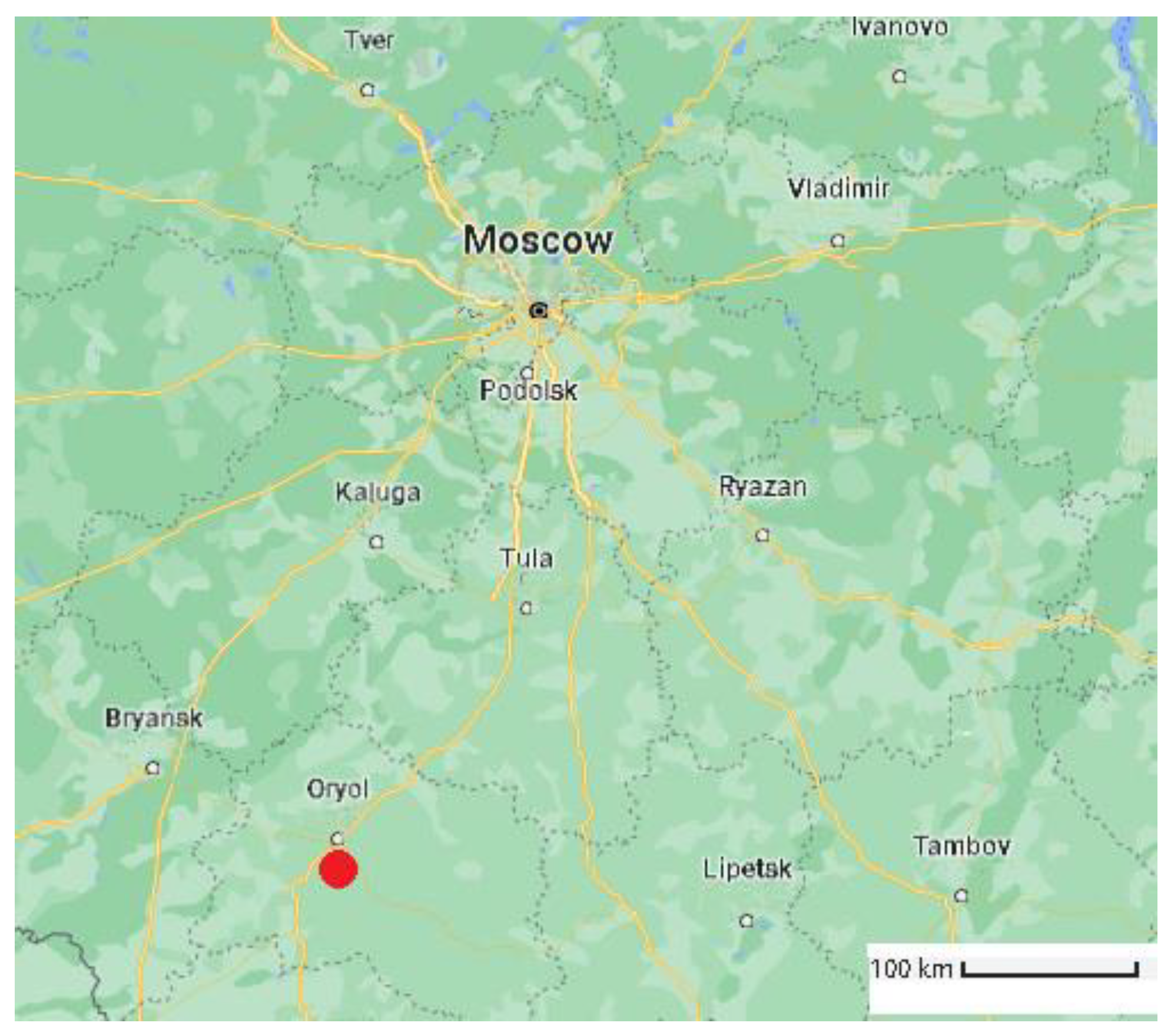
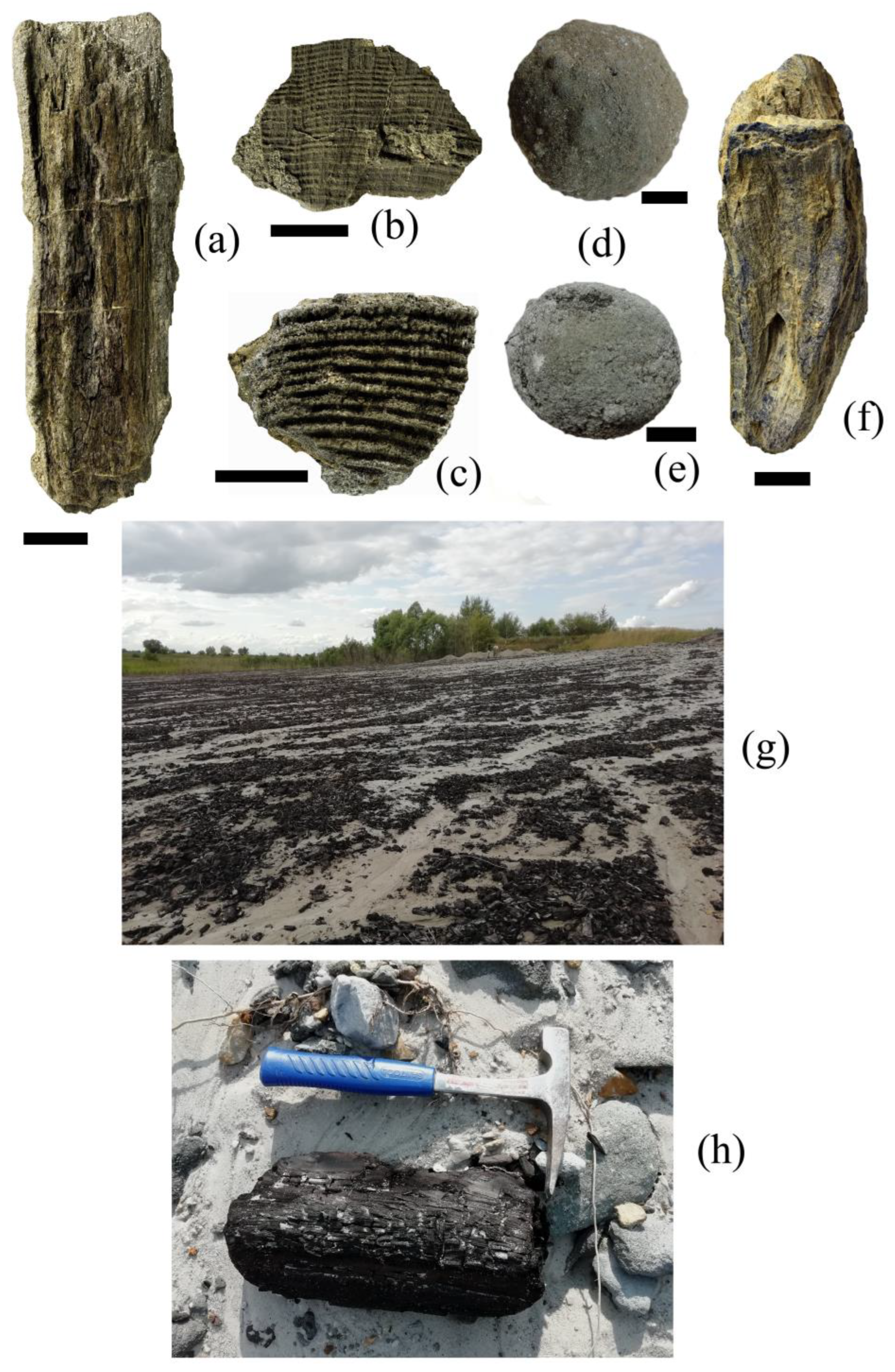
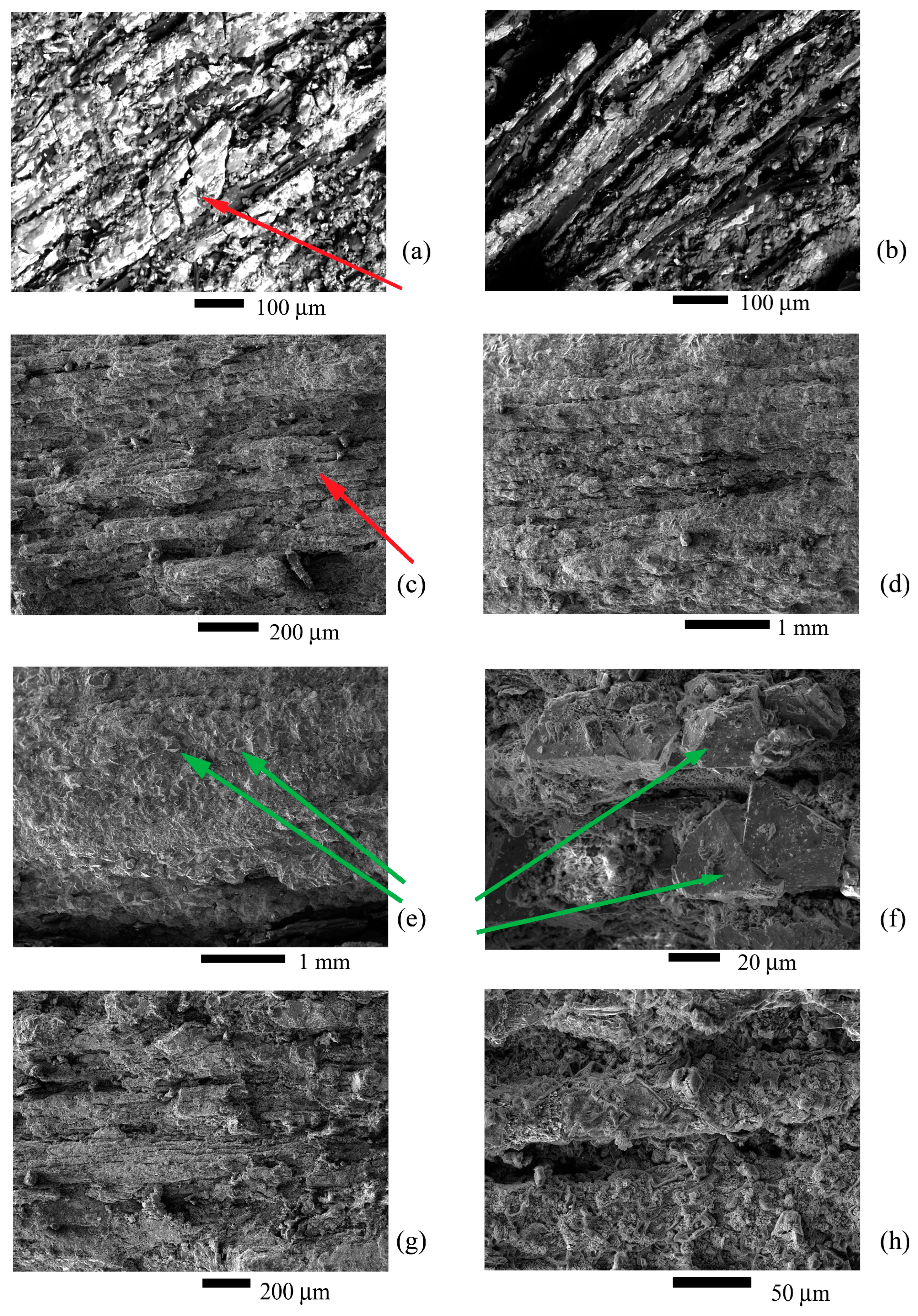
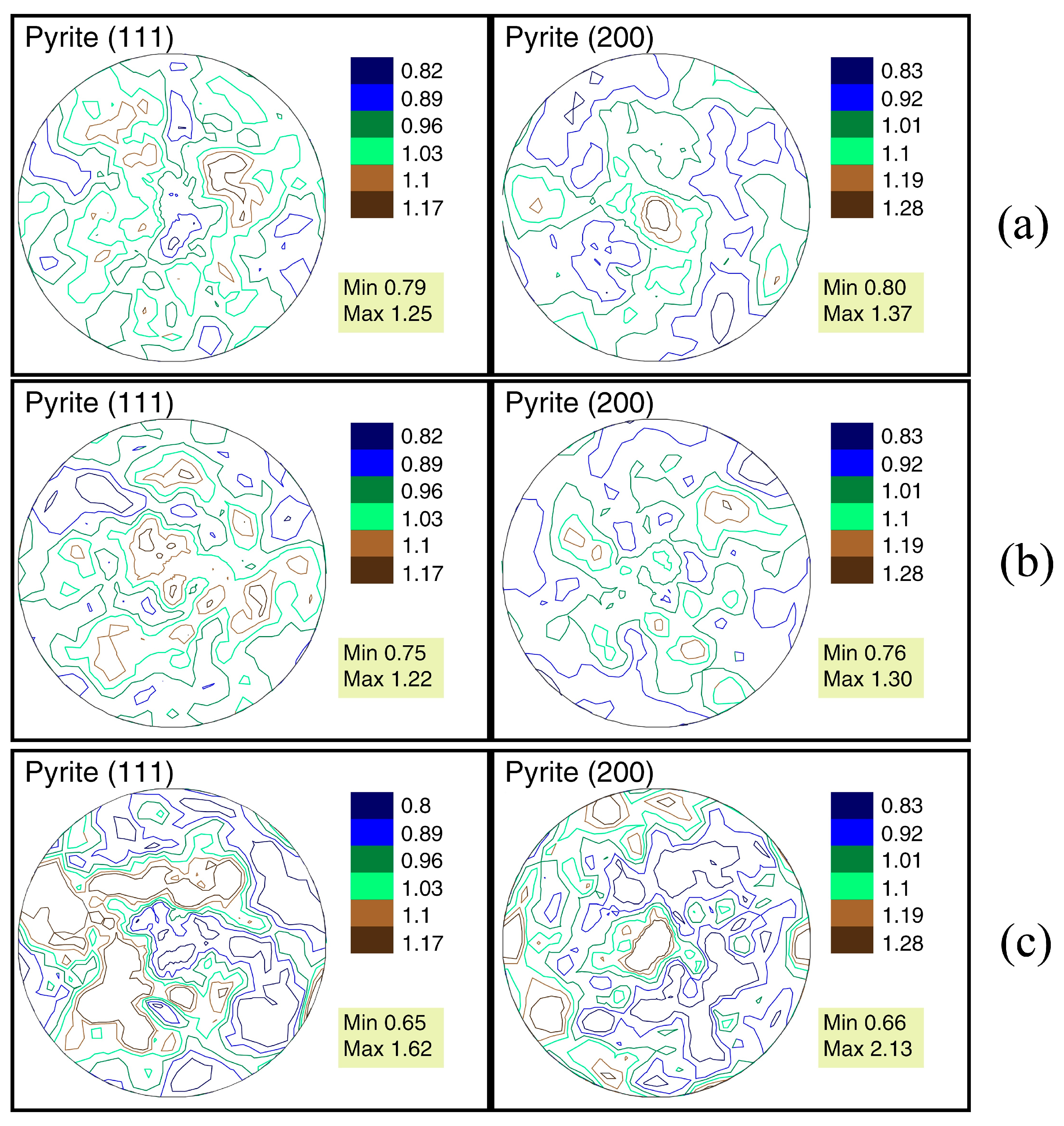
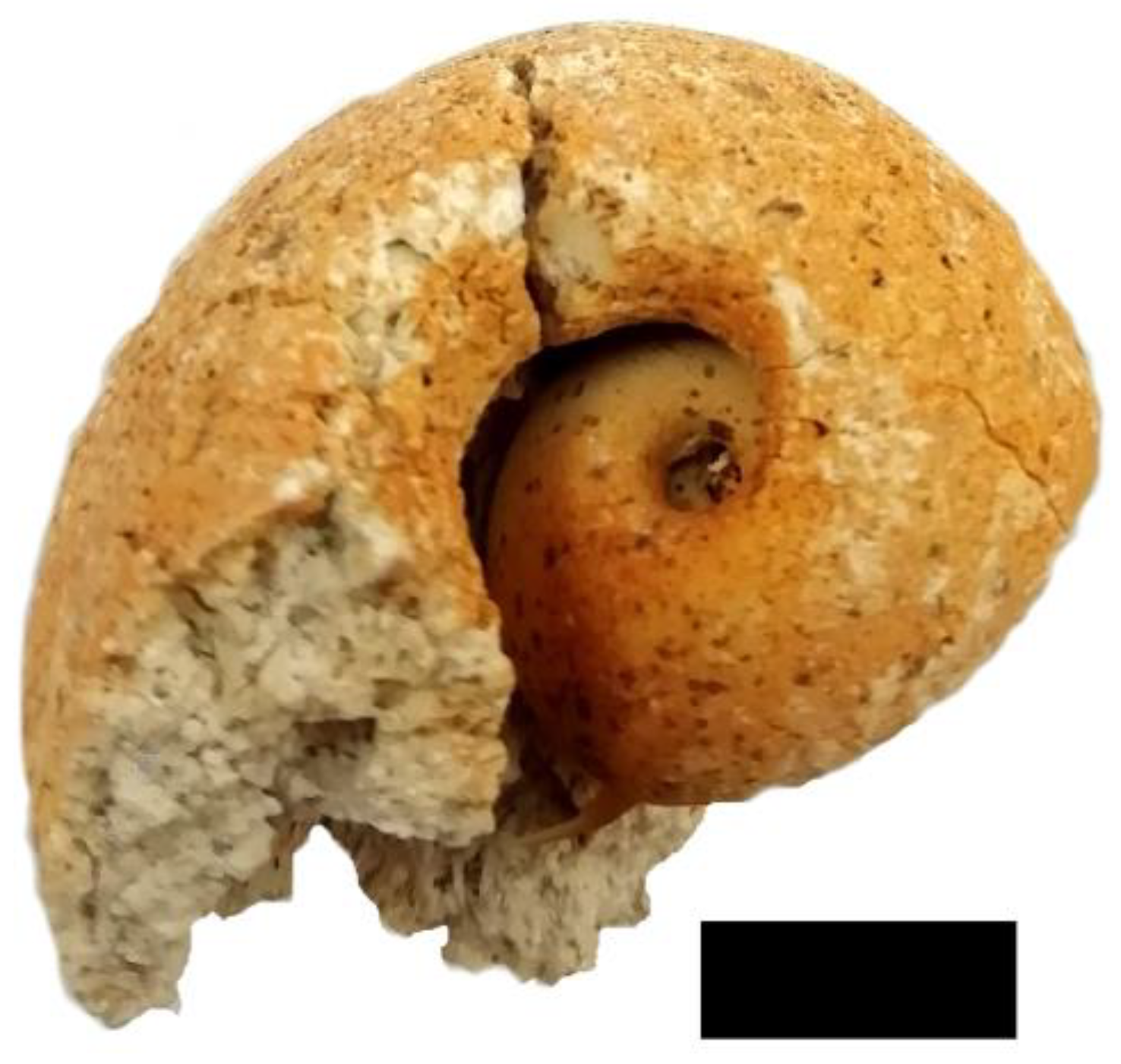

Disclaimer/Publisher’s Note: The statements, opinions and data contained in all publications are solely those of the individual author(s) and contributor(s) and not of MDPI and/or the editor(s). MDPI and/or the editor(s) disclaim responsibility for any injury to people or property resulting from any ideas, methods, instructions or products referred to in the content. |
© 2023 by the authors. Licensee MDPI, Basel, Switzerland. This article is an open access article distributed under the terms and conditions of the Creative Commons Attribution (CC BY) license (https://creativecommons.org/licenses/by/4.0/).
Share and Cite
Pakhnevich, A.; Nikolayev, D.; Lychagina, T. Global Crystallographic Texture of Pyrite in Fossil Wood (Jurassic, Oryol Region, Russia). Minerals 2023, 13, 1050. https://doi.org/10.3390/min13081050
Pakhnevich A, Nikolayev D, Lychagina T. Global Crystallographic Texture of Pyrite in Fossil Wood (Jurassic, Oryol Region, Russia). Minerals. 2023; 13(8):1050. https://doi.org/10.3390/min13081050
Chicago/Turabian StylePakhnevich, Alexey, Dmitry Nikolayev, and Tatiana Lychagina. 2023. "Global Crystallographic Texture of Pyrite in Fossil Wood (Jurassic, Oryol Region, Russia)" Minerals 13, no. 8: 1050. https://doi.org/10.3390/min13081050
APA StylePakhnevich, A., Nikolayev, D., & Lychagina, T. (2023). Global Crystallographic Texture of Pyrite in Fossil Wood (Jurassic, Oryol Region, Russia). Minerals, 13(8), 1050. https://doi.org/10.3390/min13081050





